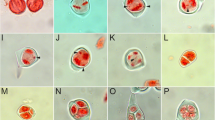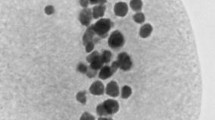Abstract
In the genus Brachiaria, genetic variation can be exploited directly from germplasm collections or released using sexual reproduction in normally apomictic polyploids. The discovery of a natural sexual polyploid accession H031 of Brachiaria humidicola collected in Africa, opened new opportunities to exploit the genetic variation in this species. This accession was crossed with an apomictic cultivar BRS Tupi with the same chromosome number (2n = 36) and 361 F1 hybrids were obtained. Following visual selection for leafiness, vigor, growth habit, and the mode of reproduction, 50 hybrids were selected for further agronomic evaluation. The parents and 45 of the 50 selected hybrids were evaluated for the regularity of meiosis. In the female parent (H031), meiosis was somewhat irregular, with 16.3% of abnormal tetrads, whereas the male (cv. BRS Tupi) meiosis was very regular, with only 3.1% of abnormal tetrads. Among hybrids (sexual and apomictic), the percentage of abnormal tetrads ranged from 15.8 to 98.3%. The abnormalities included irregular chromosome segregation, chromosome stickiness and the absence of cytokinesis. Considering that apomixis in the genus Brachiaria is pseudogamic, and that meiotic aberrations can compromise pollen viability, the results of this study present another parameter to aid selection for more stable microsporogenesis. Apomictic derivatives with stable meiosis are candidates for new cultivars whereas sexual hybrids can be retained in breeding for another round of recombination.

Similar content being viewed by others
References
Adamowski EV, Pagliarini MS, Valle CB (2008) Meiotic behavior in three interspecific three way hybrids between Brachiaria ruziziensis and B. brizantha (Poaceae:Paniceae). J Genet 87:33–38
Argel PJ, Keller-Grein G (1996) Regional experience with Brachiaria: tropical America-humid lowlands. In: Miles JW, Maass BL, Valle CB (eds) Brachiaria: biology, agronomy, and improvement. CIAT/EMBRAPA, Cali, pp 205–224
Boldrini KR, Pagliarini MS, Valle CB (2006) Abnormal timing of cytokinesis in microsporogenesis of Brachiaria humidicola (Poaceae:Paniceae). J Genet 85:225–228
Boldrini KR, Pagliarini MS, Valle CB (2009) Meiotic behavior of a nonaploid accession endorses x = 6 for Brachiaria humidicola (Poaceae). Genet Mol Res 8:1444–1450
Boldrini KR, Pagliarini MS, Valle CB (2010) Evidence of natural hybridization in Brachiaria humidicola (Rendle) Shweick (Poaceae:Panicoideae:Paniceae). J Genet 89:91–94
Felismino MF, Pagliarini MS, Valle CB (2010) Meiotic behavior of interspecific hybrids between artificially tetraploidized sexual Brachiaria ruziziensis and tetraploid apomictic B. brizantha (Poaceae). Scientia Agricola 67:1–8
Ferguson JE, Crowder LV (1974) Cytology and breeding behaviour of Brachiaria ruziziensis. Crop Sci 14:893–895
Fuzinatto VA, Pagliarini MS, Valle CB (2007) Microsporogenesis in sexual Brachiaria hybrids (Poaceae). Genet Mol Res 6:1107–1117
Gallo PH, Micheletti PL, Boldrini KR, Risso-Pascotto C, Pagliarini MS, Valle CB (2007) 2n gamete formation in the genus Brachiaria (Poaceae:Paniceae). Euphytica 154:255–260
Keller-Grein G, Mass BL, Hanson F (1996) Natural variation in Brachiaria and existing germplasm collection. In: Miles JW, Maass BL (eds) Brachiaria: biology, agronomy and improvement. CIAT/Embrapa, Columbia. CIAT/EMBRAPA, Cali, pp 16–42
Mendes-Bonato AB, Pagliarini MS, Valle CB, Penteado MIO (2001) A severe case of chromosome stickiness in pollen mother cells of Brachiaria brizantha (Hochst.) Stapf (Gramineae). Cytologia 66:287–291
Mendes-Bonato AB, Pagliarini MS, Forli F, Valle CB, Penteado MIO (2002) Chromosome number and microsporogenesis in Brachiaria brizantha (Gramineae). Euphytica 125:419–425
Mendes-Bonato AB, Pagliarini MS, Risso-Pascotto C, Valle CB (2006a) Chromosome number and meiotic behavior in Brachiaria jubata (Gramineae). J Genet 85:83–88
Mendes-Bonato AB, Risso-Pascotto C, Pagliarini MS, Valle CB (2006b) Cytogenetic evidence for genome elimination during microsporogenesis in interspecific hybrid between Brachiaria ruziziensis and B. brizantha (Gramineae). Genet Mol Biol 29:711–714
Miles JW, Maass BL, Valle CB (1996) Brachiaria: biology, agronomy, and improvement. CIAT/Embrapa, Colombia. CIAT/EMBRAPA, Cali
Ndikumana J (1985) Etude de l’hybridation entre espèces apomictiques et sexuées dans le genre Brachiaria. PhD dissertation, Université Catholique de Louvain, Belgium
Pagliarini MS, Risso-Pascotto C, Souza-Kaneshima AM, Valle CB (2008) Analysis of meiotic behavior in selecting potential genitors among diploid and artificially induced tetraploid accessions of Brachiaria ruziziensis (Poaceae). Euphytica 164:181–187
Renvoize SA, Clayton WD, Kabuye CHS (1996) Morphology, taxonomy, and natural distribution of Brachiaria (Trin.) Griseb. In: Miles JW, Maass BL, Valle CB (eds) Brachiaria: biology, agronomy, and improvement. CIAT/Embrapa, Colombia. CIAT/EMBRAPA, Cali, pp 1–15
Risso-Pascotto C, Pagliarini MS, Valle CB (2005) Meiotic behavior in interspecific hybrids between Brachiaria ruziziensis and Brachiaria brizantha (Poaceae). Euphytica 145:155–159
Risso-Pascotto C, Pagliarini MS, Valle CB (2006a) Microsporogenesis in Brachiaria dictyoneura (Fig. & De Not.) Stapf (Poaceae:Paniceae). Genet Mol Res 5:837–845
Risso-Pascotto C, Pagliarini MS, Valle CB (2006b) A new basic chromosome number for the genus Brachiaria (Trin.) Griseb. (Poaceae:Panicoideae:Paniceae). Genet Res Crop Evol 53:7–10
Souza-Kaneshima AM, Simioni C, Felismino MF, Mendes-Bonato AB, Risso-Pascotto C, Pessim C, Pagliarini MS, Valle CB (2010) Meiotic behavior in the first interspecific hybrid between B. brizantha and B. decumbens. Plant Breed 129:186–191
Swenne A, Louant BP, Dujardin M (1981) Induction par la colchicine de formes autotétraploïdes chez Brachiaria ruziziensis Germain et Evrard (Gramínée). Agron Trop 36:134–141
Valle CB, Glienke C (1991) New sexual accession in Brachiaria. Apomixis Newsl 7:42–43
Valle CB, Pagliarini MS (2009) Biology, cytogenetics, and breeding of Brachiaria. In: Singh RJ (ed) Genetic resources, chromosome engineering, and crop improvement. CRC Press, Boca Raton, pp 103–151
Valle CB, Savidan Y (1996) Genetics, cytogenetics, and reproductive biology of Brachiaria. In: Miles JW, Maass BL, Valle CB (eds) Brachiaria: biology, agronomy, and improvement. CIAT/Embrapa, Colombia. CIAT/EMBRAPA, Cali, pp 147–163
Acknowledgments
Authors are grateful to UNIPASTO and CNPq for financial support.
Author information
Authors and Affiliations
Corresponding author
Rights and permissions
About this article
Cite this article
Ricci, G.L., de Souza-Kaneshima, A.M., Pagliarini, M.S. et al. Meiotic behavior in Brachiaria humidicola (Poaceae) hybrids. Euphytica 182, 355–361 (2011). https://doi.org/10.1007/s10681-011-0486-y
Received:
Accepted:
Published:
Issue Date:
DOI: https://doi.org/10.1007/s10681-011-0486-y




